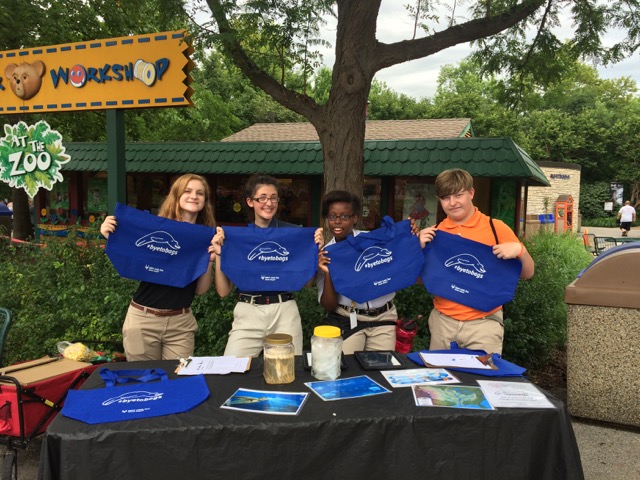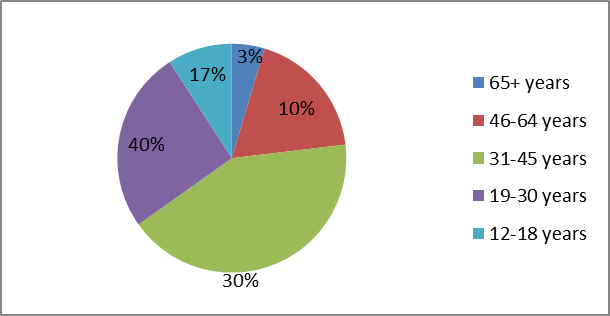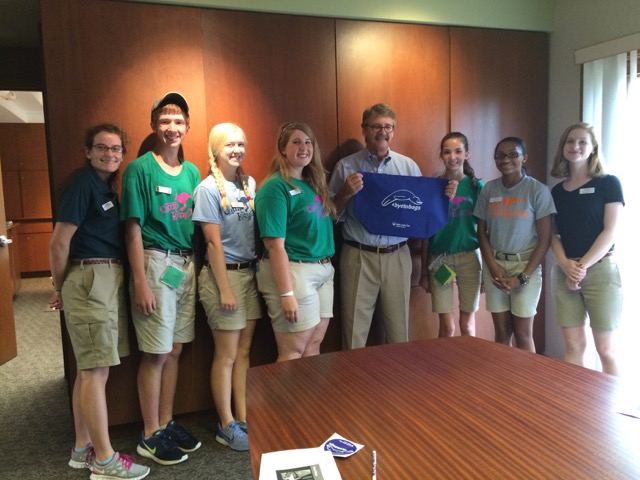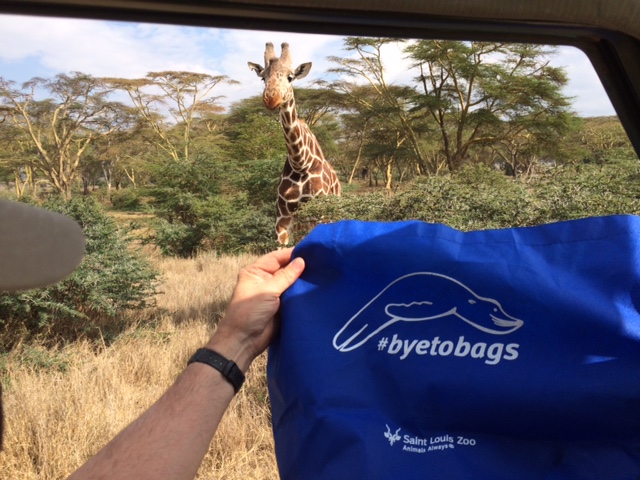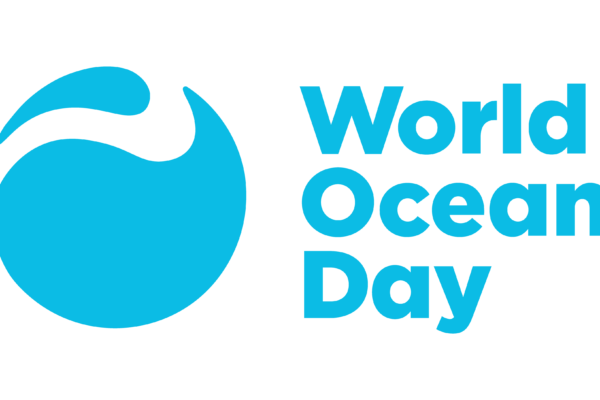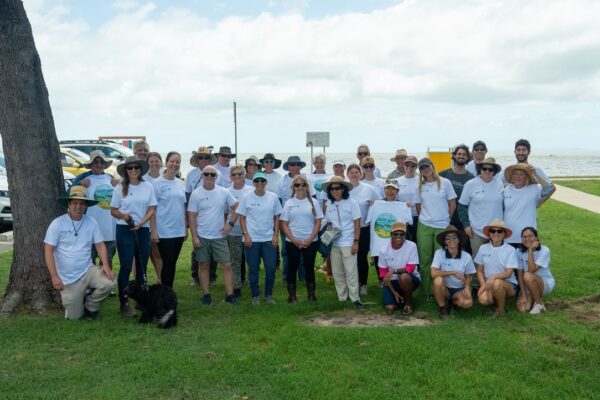This guest post is submitted by Kirinne Slaughter at the Saint Louis Zoo, and is the last in a 3-part series on their Innovative Solutions Grants+ project.
It is hard to believe that it has been almost a year since we began our partnership with The Ocean Project under the Innovative Solutions Grants+ Program. It has been an exciting and rewarding year for everyone involved in the project, especially our Zoo ALIVE teen volunteers as they have developed and implemented the #byetobags campaign. (See previous post). This campaign, based on the successes of the Better Bag Challenge, aimed to get Zoo visitors to make the change to reusable bags. For our innovative twist, we used social media in an attempt to amplify the effects of our on-grounds campaign.
KEY FINDINGS
As our data collection comes to a close with the end of our summer event season, we have concluded that social media can be an invaluable tool to increasing the effectiveness of an on-grounds campaign. Specifically, our results can be summarized into three key findings:
- Our on-grounds campaign confirmed the success of the public engagement model from the Better Bag Challenge. Since our first official event on April 23rd, 90% of guests that were asked during their visit to take the pledge did so, and most did so with enthusiasm! The teens approached guests who came near their activity table, connected the problem of plastics in our ocean to its impact on the animals using their own messaging (as I’ll explain later), and then asked guests to pledge to avoid disposable plastic bags in exchange for a reusable bag. And, again, a remarkable 90% of those who were asked filled out a pledge form and “signed” it by providing us with their email address. One guest even hugged each teen, thanking them for the work they were doing. As of the end of August, 1,373 visitors pledged to switch from plastic bags to reusable bags, and 1,669 #byetobags reusable bags have been given away!
To “gut check” our impact, we also tracked the taking of small and medium plastic bags in our gift shops, where bags are available upon request, and found that use was down 9% since the beginning of the year, while the sale of reusable bags had increased by 65%! While our project can’t claim credit for all of this impact, it certainly was reassuring to see the trend moving in the right direction.
- We also tried to generate pledges, and found a consistent (but comparatively low) return on investment. As a part of our project, we wanted to know if we could get people to take our pledge through social media, with no interaction on grounds and no bag in return. We embedded links to the pledge page into #byetobags social media accounts and posts we created on Facebook, Twitter, Tumblr and Instagram, as well as onto the Saint Louis Zoo website.
While the social media platforms garnered a consistent number of pledges each week, we found that when comparing the number of pledges generated with the number of hours invested, our teens were much more effective - by our estimates more than twice as effective - in their on-grounds engagements.
But, we concluded that our social media effort was still important, especially when thinking in broader terms of increasing our project’s overall reach. Of the platforms that we did use, the #byetobags Facebook page was our most successful in this regard - in spite of the teens’ initial doubts! - growing to nearly 300 likes and a reach of over 25,000 - it proved to be a great platform to engage with individuals, including but not limited to those who completed the pledge form. Meanwhile, Twitter was our second most successful platform, used primarily for interacting with other plastic pollution organizations, and making professional connections such as St. Louis City Recycling and Earth Share. So having a variety of social media accounts was useful for us, as each platform can be utilized in different ways including and beyond generating pledges.
- We learned that those who took the pledge were willing to share their commitment with friends and family, but did not utilize the mechanisms that we created and provided to them. We created a platform with our email service provider through which we emailed every person who took the pledge, giving them the option to then share the pledge out to their friends and family by using one of our preset share buttons that would link them either to Facebook, Twitter, or their email. While we were anticipating a snowball effect, we found that this method did not see the success in which we had hoped. Only a handful of visitors - less than 5 of the nearly 1,600 pledge takers - used the social sharing options we provided to them via email, with 42 total unique social shares.
Surprisingly, though, some visitors were very willing to share the pledge utilizing a different method, one that we originally did not anticipate – they copied and pasted the link to our pledge page into their own posts and used #byetobags. Our teens found more than 10 examples where visitors did this, with one person even sharing out the pledge in a Google link format she created, generating another 8 pledges. It seems our guests are willing to share the message, but we need to rethink how we help them to do it!
Who takes the #byetobags pledge?
 As a part of our pledge form, we gave guests the option to select their age group from a drop down menu, and to answer the question, “How often do you use reusable bags?” These questions give us some insight into who is most often taking our pledge on-grounds versus who is most often taking our pledge online. As shown in the charts, we found that on grounds the most common age group of pledge takers were 31-45 year olds, while online it was 12-18 years olds. This suggests that social media accounts can help us reach a distinct group of pledge takers, notably the youth that research tells us are so important to our missions, and who may be more likely to pledge to conservation action via the internet.
As a part of our pledge form, we gave guests the option to select their age group from a drop down menu, and to answer the question, “How often do you use reusable bags?” These questions give us some insight into who is most often taking our pledge on-grounds versus who is most often taking our pledge online. As shown in the charts, we found that on grounds the most common age group of pledge takers were 31-45 year olds, while online it was 12-18 years olds. This suggests that social media accounts can help us reach a distinct group of pledge takers, notably the youth that research tells us are so important to our missions, and who may be more likely to pledge to conservation action via the internet.
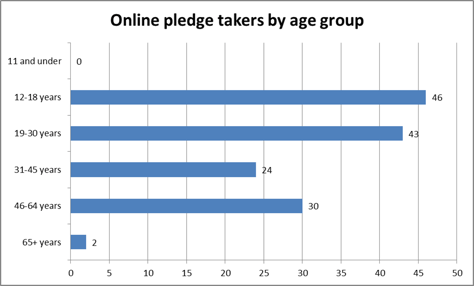 Additionally, of the 1,521 total pledge takers who choose to answer the question, “How often do you use reusable bags?” 57% stated that they either “often” or “always” use reusable bags, which was notably higher than the 40% of the public reported by the grocery industry as the national average (Source: http://www.fmi.org/research-resources/u-s-grocery-shopper-trends/grocerytrends2014) So our pledge may have been more of a reinforcement and reminder to those who already use reusable bags, with encouragement to share with others. It will be an interesting challenge as we move forward to see how we can do better, on our own and with our guests, at reaching those who rarely or never use reusable bags. Our goal of course being that one-day, everyone will select, “always.”
Additionally, of the 1,521 total pledge takers who choose to answer the question, “How often do you use reusable bags?” 57% stated that they either “often” or “always” use reusable bags, which was notably higher than the 40% of the public reported by the grocery industry as the national average (Source: http://www.fmi.org/research-resources/u-s-grocery-shopper-trends/grocerytrends2014) So our pledge may have been more of a reinforcement and reminder to those who already use reusable bags, with encouragement to share with others. It will be an interesting challenge as we move forward to see how we can do better, on our own and with our guests, at reaching those who rarely or never use reusable bags. Our goal of course being that one-day, everyone will select, “always.”
#byetobags continues at the Saint Louis Zoo program
Thanks to funding from a Saint Louis Zoo family donor, the #byetobags campaign will be able to continue at the Saint Louis Zoo for another year! As mentioned in the previous blog post, this campaign is the first of its kind at the Saint Louis Zoo, and the opportunity to continue will allow for further fine tuning, paving the road for the Zoo to have many more in the future. We have a number of very targeted goals for the upcoming year, including:
- Implementing a bag policy in the gift shops that is more in line with our #byetobags messaging. We had some initial success as noted above, and will continue working with our retail team, as well as the Business and Strategic Operations Departments at the Zoo to come up with a bag policy that works for all.
- We are also looking forward to pushing our message further outside the Zoo into the St. Louis community. To launch this, the #byetobags campaign is going to be the feature article in our quarterly stlzoo magazine that goes out to all 50,215 of our membership households. Additionally, our Zoo ALIVE teen volunteers are anxious to continue to spread the message to their high schools and our Young Zoo Friends board, a group of young professionals who are Zoo members, are extremely interested in the campaign and are eager to take the message back to their home companies and organizations.
- Finally, the Saint Louis Zoo is excited to be hosting a Youth Ocean Conservation Summit on our campus on February 11, 2017. Youth Ocean Conservation Summit is a youth-oriented conference whose goal is to educate about how to turn a conservation idea into an action project. The event will feature notable speakers and workshops that will teach young people the skills they need to start a conservation project. We are excited to be hosting the first summit in the Midwest, and are eager to feature #byetobags as an example of a youth run campaign.
We are eager to see where the second year of the #byetobags campaign takes us. All departments at the Zoo have been supportive of the project and the possibilities for expansion are truly endless!
Advice to others
As we reflect back on the creation of our campaign, it is an honor for us to be able to offer advice to other institutions hoping to create similar campaigns.
- Guests are excited to be asked to partake in a conservation action campaign. Our results confirmed The Ocean Project’s finding that they do indeed expect, trust, and appreciate the advice that you have to offer them on how they could become part of the plastic pollution solution. Not only were our guests willing to sign a pledge, but some were willing to share that pledge with friends and family, and stay invested in a conservation action campaign on social media – we just need to give them more flexibility to share more easily and on their own terms.
- Use multiple social media platforms, manage each separately, and play to their strengths. Managing each separately, as opposed to making one post for all, allows you to truly tailor the post to each platform’s strengths.
- Allow for teens to be creative and experimental in messaging. One of the most exciting and successful parts of our campaigns was allowing the teens to experiment with the delivery of the #byetobags message. The emphasis was on connecting the requested action to its importance for the animals, but the teens also were given the ability to deliver the #byetobags message in the way that was most comfortable for them, they were more excited, and more eager to get pledges.
- Finally, one thing that worked out well for us was that for this project we hired a part-time campaign coordinator, funded by the ISG+ grant. Having someone completely devoted to the #byetobags campaign made communication, facilitation and advocacy about the campaign seamless, and gave the Zoo ALIVE Teen’s a great resource for the project. It also allowed for the message to spread further and faster as the campaign was not limited by staff attention or availability.
Overall, this year has been amazingly rewarding. As one Zoo ALIVE teen volunteer, Kiara Hardmon states, “I am really proud to have made an impact for the environment at such a young age.” As the project continues, we are eager to allow more Zoo ALIVE teens the opportunity to work on a project that allows them to feel proud of themselves, while positively influencing the environment around them!

